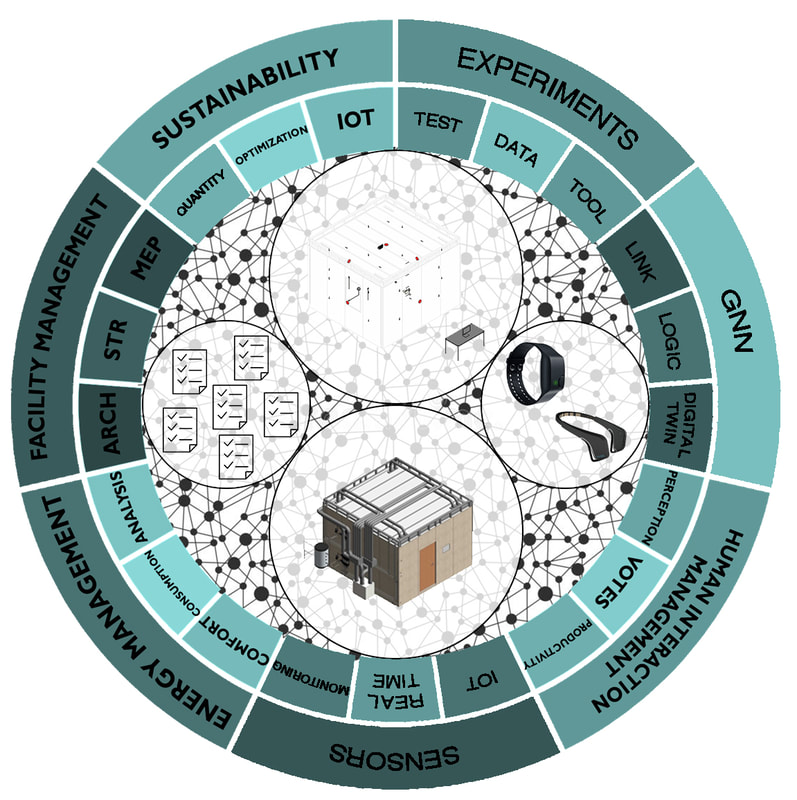our large research infrastructures
EAPLAB research and development infrastructures are oriented toward the investigation of 2 main directions:
1. Smart materials for the built environment aimed at energy efficiency, comfort, and Urban heat Island mitigation
2. Human-centric design and environmental monitoring/mapping, with a multidomain approach (thermal, visual, air quality, acoustics, physiology, psychology) for indoor-outdoor comfort and resilience.
Find below some of the strategic assets used and supported in EU projects, national projects, consultancy activities for private companies and public institutions.
1. Smart materials for the built environment aimed at energy efficiency, comfort, and Urban heat Island mitigation
2. Human-centric design and environmental monitoring/mapping, with a multidomain approach (thermal, visual, air quality, acoustics, physiology, psychology) for indoor-outdoor comfort and resilience.
Find below some of the strategic assets used and supported in EU projects, national projects, consultancy activities for private companies and public institutions.
Human-centric environment and infrastructures
The Next RoomNext.Room is the EAPLAB testroom for human comfort studies. The facility (built up in 2020) is located inside one of the CIRIAF laboratories at the engineering campus of the University of Perugia. The facility aims to be an innovative and flexible instrument to deepen the research on multidimensional indoor/outdoor comfort. The facility (4x4x2.7 m) is accessible from a door facing a window, with an integrated shading system, and which is in line with laboratory windows providing access to the outside view from inside the Next.Room. Despite the internal position of the facility, the walls are well insulated to allow a high efficiency performance of the conditioning systems: two heat pumps exchange energy independently with an air system and with a radiant system that covers all the internal surfaces, giving the chance to have only a half of each face working. Lighting system is made of four led panels flanked by two RGB dimmable reflector. The Next.Room is fully monitored to get real-time information and control over its thermal, visual, and air quality conditions from the remote central PC located outside the facility. To overcome the limits imposed by the physical environment, an integrated virtual reality device is installed in the room. Further developments will also allow motion devices to guarantee a complete virtual experience.
DIGITAL TWIN for human-centric design: whole comfort assessment and energy efficiency perspectiveThe EAP LAB research group is investigating the practical application of the Digital Twin paradigm by combining Building Information Modeling and Graphical Neural Networks. We are including the As-Built and As-monitored BIM models within the flexibility of the GNNs to empower the capability of our twins to replicate and evolve with the complex systems that are being digitalized. This technology is currently applied on the NEXT.ROOM, a novel test room built up for addressing the complexity of human perception, and new applications will be developed involving a larger scale. The final aim of our research is to deliver a digital twin able to capture the complex dynamics of the human-building-energy system, a new series of tools for scientists and corporates to empower the managing capability of their assets.
|
The SURBEXSURBEX is a large scale pavement infrastructure hosting 12 pavement fields by 20 sqm each. which are continuously exposed to ambient boundary conditions and continuously monitored. Such monitoring is aimed at evaluating the environmental performance of the tested smart and innovative pavements during the course of the time, also considering pedestrians' comfort conditions from a thermal, acoustic, visual and air quality perception. Permanent monitoring stations include the capability to collect information about air temperature and relative humidity, air velocity at different levels above the ground, solar radiation and albedo at short and log wavelenght, illuminance, sound pressure, PMx. Specific tests are carried out for scientific and commercial purposed in order to evaluate field realistic performance before street and square installations. The infrastructure has been supprted by SAFERUP marie Curie ITN project at CIRIAF. See the link below for more information about our research for mitigating urban heat island!
|
Smart materials facilitiesThe EAPLAB is continuously searching for the development and characterization of innovative materials for the built environment.
From the small to the large scale of investigation, we are much interested in smart materials with advanced properties to be implemented as active or passive solutions for the mitigation of urban overheating and energy consumption. Thanks to newly designed and equipped laboratory facilities, our approach may range from materials’ multiphysics characterization under controlled boundary conditions to their actual implementation in in-field realistic infrastructures, up to the study of their interaction at the inter-building scale through acknowledged urban canopy models. Materials’ thermal, optical, acoustic, and mechanical performances are the main focus of our research, but their impacts on citizens' comfort and environmental sustainability are also deeply investigated. The main LAB infrastructures consist of: 3 environmental simulation chambers (by ATT and Matest) with solar simulators and controlled atmosphere, 2 real buildings in the outdoors with possibility to change envelope materials and finishing after LAB prototyping and optimization, hot disk, thermal-cycler, spectro-radiometer with integrating sphere, FTIR, DSC, TGA, profilometer, spectrophotometer with thermal control and integrating sphere. The EAP LIVING LABThe EAP LIVING LAB consists of a full scale monitored building for office use, where 5 rooms are continuously monitored in terms of personal energy need, temperature and relative humodity, illuminance level above the desk, opening-closing of doors and windows. 5 to 15 people daily occupy those monitored spaces, and they are typically also monitored in terms of physiological paramaters and working-nonworking behaviors (training, metabolic rates, etc.).
The living lab is currently under investigation also within the network of living labs reviewed by the Annex 79 supported by the International Energy Agency, and it was one of the building case studies of Annex 66 just concluded. All the experiments are aimed at assessing the role of occupants attitudes in energy needs and their multidomain comfort perception related to their behaviors. |





